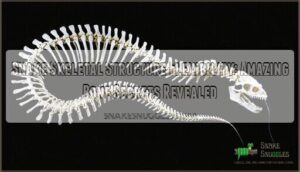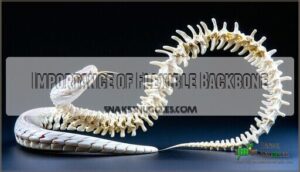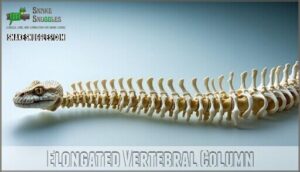This site is supported by our readers. We may earn a commission, at no cost to you, if you purchase through links.

Snakes possess up to 450 vertebrae compared to your 33, creating an accordion-like backbone that bends in ways that’d make a yoga instructor jealous.
Their skulls contain roughly 30 bones connected by stretchy ligaments that work like biological rubber bands.
This allows their jaws to dislocate and open 160 degrees – nearly seven times wider than you can manage.
The quadrate bone acts as a special hinge, while their split lower jaw halves move independently.
This incredible flexibility isn’t just for show – it lets them swallow prey twice their head’s diameter and squeeze through impossibly tight spaces.
The secret lies in elastic ligaments replacing rigid connections found in most animals, giving snakes their signature fluid movement and hunting prowess.
Table Of Contents
- Key Takeaways
- Snake Skeleton Flexibility
- Importance of Flexible Backbone
- Structure of Snake Vertebrae
- Adaptations for Different Environments
- Benefits of Flexibility in Snakes
- Frequently Asked Questions (FAQs)
- Why do snakes have a flexible skeleton?
- What adaptations are found in snake skeletons?
- What is a snake skeleton?
- How does a snake skeleton work?
- Why is a snake’s spine flexible?
- What skeletal structure does a snake have?
- What makes snakes so flexible?
- What is unusual about the snakes’ skeletal system?
- Why do snakes have a flexible backbone?
- What is the skeletal structure of a snake?
- Conclusion
Key Takeaways
- You’ll find snakes have up to 450 vertebrae compared to your 33, creating an accordion-like backbone that bends in ways impossible for rigid-spined animals
- Their skulls contain 30 bones connected by stretchy ligaments that let them dislocate their jaws and open 160 degrees – nearly seven times wider than you can manage
- These flexible ligaments act like biological rubber bands throughout their skeleton, replacing the rigid connections found in most animals and enabling fluid movement
- This incredible flexibility isn’t just impressive – it’s their survival toolkit that lets them swallow prey twice their head size, squeeze through impossibly tight spaces, and escape predators with lightning-fast direction changes
Snake Skeleton Flexibility
You’ll be amazed at how a snake’s skeleton bends and twists, thanks to hundreds of vertebrae and flexible ligaments working together.
Don’t be surprised if you catch one squeezing through a crack or swallowing a meal twice its size—nature’s contortionists have mastered the art of flexibility.
Unique Skull Structure
Snake skull anatomy features approximately 30 skull bones connected by flexible ligaments rather than rigid sutures.
This puzzle structure enables extraordinary jaw movement and dislocation ability. Their vertebrae support this unique skull structure, allowing jaw flexibility that’s unmatched among animals.
Researchers utilize CT scanner technology to study the intricate details of snake skulls.
Here’s what makes snake skulls extraordinary:
- Independent bone movement – Each skull bone moves separately for maximum flexibility
- Quadrate bone pivot – Acts as a hinge for extreme jaw opening
- Split lower jaw – Two halves connected by stretchy ligaments
- Kinetic joints – Multiple connection points enable multi-directional movement
- Elastic oral cavity – Mouth lining expands to accommodate oversized prey
Flexible Ligaments and Bones
Examining snake skeletal structure flexibility reveals remarkable engineering.
You’ll find their flexible ligaments act like biological rubber bands, connecting bones with extraordinary joint mobility.
This skeletal adaptation creates unmatched freedom of movement through specialized cartilage function and ideal bone density.
- Ligaments stretch like elastic bands, allowing 180-degree jaw expansion
- Vertebral connections bend like a living accordion through hundreds of joints
- Cartilage cushions provide shock absorption during powerful constriction movements
This flexible backbone system transforms ordinary bones into a masterpiece of skeletal system flexibility.
Advantages of Flexible Skeleton
Imagine this: your body’s like a rigid toolbox, but snakes evolved with flexible joints that work like a master key.
Nature’s ultimate escape artist: snakes turn their flexible spines into living master keys that unlock any tight spot.
Their skeletal efficiency creates enhanced mobility through adaptive bones connected by stretchy ligaments.
This flexible vertebral column enables incredible survival tactics – swallowing prey twice their head size and squeezing through impossibly tight spaces.
These skeletal flexibility advantages make snakes nature’s ultimate escape artists and efficient predators.
The unique structure of their bones is due to their vertebral bone development, which plays a vital role in their ability to move and hunt.
Comparison to Other Animals
Compared to most vertebrates, you’ll find snakes have evolutionary tradeoffs that set them apart dramatically.
While mammals possess rigid skulls with fused jaws, reptile bone structure in snakes features loosely connected bones and stretchy ligaments.
This vertebral flexibility creates massive skeletal differences – snakes can open their mouths 160° versus humans’ measly 26°.
Their flexible vertebral column with up to 450 vertebrae (compared to our 33) grants flexibility advantages that enable swallowing prey larger than their heads.
These species variations in reptilian skeletal flexibility deliver skeletal flexibility benefits unmatched in nature.
The study of vertebral bone development has shed new light on the unique characteristics of snakes.
Importance of Flexible Backbone
You’ll discover that a snake’s flexible backbone isn’t just impressive—it’s the secret behind their incredible survival skills.
This remarkable spinal design enables four distinct movement types, from lightning-fast strikes to stealthy escapes through impossibly tight spaces.
Relationship Between Flexibility and Movement
When you think about how snakes move, it’s like watching a masterclass in vertebral flexibility. Their snake spine anatomy transforms kinetic energy into pure locomotion magic through specialized skeletal adaptations. Each vertebra connects through five articulation points, creating joint flexibility that lets up to 100 vertebrae participate in a single bend.
Movement Patterns showcase this flexibility in snakes beautifully:
Understanding the role of pharyngeal constrictors is also essential, as seen in the study of constrictor muscle anatomy.
Locomotion Modes rely entirely on this incredible slithering motion mechanics. Without rigid joints holding them back, snakes convert their flexible backbone into a living wave machine that conquers any terrain.
Types of Movement Enabled by Flexibility
Your snake’s flexible skeletal systems reveal four remarkable movement patterns.
Lateral Movement creates those classic S-shaped undulating waves you see in grass.
Concertina Motion works like an accordion for tight spaces.
Sidewinding Technique lets desert species dance across hot sand.
Rectilinear Progression enables straight-line slithering motion mechanics through burrows—no fancy coiling mechanism required, just pure efficiency.
Understanding snake movement systems design is essential for appreciating these unique patterns.
Hunting and Escaping Predators
Flexible spines transform snakes into precision hunting machines and escape artists.
Their slithering patterns confuse prey while snake joint flexibility enables lightning-fast strikes and powerful constriction.
Prey capture becomes effortless when you can dislocate your jaw and swallow meals twice your head size.
For predator evasion, that same flexibility in snakes allows instantaneous direction changes and squeezing through impossibly tight spaces.
Hunting tactics rely on snake movement patterns that maximize stealth, while escape mechanisms exploit every crack and crevice available.
Hunting Advantages Escaping Advantages
Access to Various Environments
You’ll discover how snakes gain access to nature’s secret doors through their incredible flexibility.
Their bendable backbone acts like a master key, granting Environmental Adaptation across countless habitats.
Watch as snake skeletal structure enables seamless Terrain Navigation:
- Desert dunes: Sidewinding through shifting sands
- Forest canopies: Coiling around branches effortlessly
- Underground burrows: Squeezing through tight tunnels
- Aquatic environments: Undulating through water currents
This flexible backbone transforms ordinary movement into extraordinary Spatial Exploration, making Ecosystem Access possible everywhere.
Structure of Snake Vertebrae
You’ll discover that snake vertebrae form the backbone of their incredible flexibility, with each bone designed like a precision-engineered joint.
These specialized vertebrae connect through multiple contact points, allowing snakes to bend their bodies into seemingly impossible shapes while maintaining structural strength.
Elongated Vertebral Column
How does a snake’s elongated vertebral column achieve such remarkable spinal flexibility?
You’ll find their bone structure contains 200-400 vertebrae, each connecting through specialized joints that create unmatched skeletal adaptation.
These vertebrae link via ball-and-socket connections plus additional surfaces, allowing up to 30-degree articulation angles.
Flexible ligaments bind this intricate snake skeletal structure together, providing column stability while enabling extraordinary bending.
This flexible backbone lets snakes coil their entire body into tight spirals—imagine wrapping yourself into a pretzel!
Their vertebral design perfectly balances strength with mobility.
Number of Vertebrae in Different Species
Vertebral count varies dramatically across snake species, ranging from 115 to 546 vertebrae.
Your average python packs around 400, while a stubby puff adder manages with just 180.
Here’s what drives these differences:
- Body length adaptations – longer species require more vertebral segments
- Environmental specialization – arboreal snakes need extra flexibility for branch navigation
- Hunting strategy demands – predator needs influence vertebral structure
- Evolutionary lineage patterns – related species share similar vertebral counts
Hypapophyses and Their Functions
You’ll find hypapophyses jutting downward from snake vertebrae like tiny hooks.
These specialized bone projections serve dual purposes in snake vertebral structure.
First, they enhance Vertebral Stability by providing additional muscle attachment points along the elongated vertebral column.
Second, egg-eating species use them as built-in shell crackers—nature’s perfect tool for accessing breakfast.
Egg-eating
This Skeletal Adaptation showcases how Flexible Joints and specialized Bone Structure work together, creating the flexible backbone that defines snake locomotion.
Ribs and Their Role in Movement
Understanding snake rib structure reveals nature’s engineering marvel.
Each vertebra connects to two flexible ribs, creating a complex rib structure that’s unattached to any sternum.
This rib mobility lets snakes expand dramatically when swallowing prey—imagine your ribcage stretching like a balloon!
Rib articulation drives breathing since snakes lack diaphragms, while rib movement anchors powerful muscles for undulation.
These flexible ribs provide essential skeletal support, making their flexible backbone system incredibly versatile.
The unique characteristics of snake anatomy are closely related to their snake rib structure and overall physiology.
Adaptations for Different Environments
You’ll discover how snake skeletal systems have evolved incredible adaptations that let them thrive in trees, underground burrows, ocean depths, and open terrain.
Each environment has shaped their bone structure differently, creating specialized features that would make any engineer jealous of nature’s design solutions.
Arboreal Snakes and Their Adaptations
Looking at tree climbing, you’ll notice arboreal snakes showcase incredible skeletal adaptations.
Their flexible backbone features elongated, narrow vertebrae enabling precise branch navigation through dense leaf habitat.
Flexible ligaments and specialized vertebral articulation create the perfect toolkit for forest ecology survival.
These skeletal adaptations allow aerial hunting while maintaining balance on thin branches, making arboreal snakes nature’s ultimate acrobats.
Burrowing Snakes and Their Adaptations
While arboreal species master vertical terrain, burrowing snakes become underground engineers.
Their flexible backbone and specialized skeletal adaptations enable precise Soil Penetration and Burrow Architecture.
Flexible ligaments and enhanced vertebral articulation create Tunnel Stability while traversing subterranean mazes.
These Underground Navigation masters use Snake Camouflage and reinforced skulls to push through dense earth, accessing hidden prey networks.
The study of snake skeleton systems is vital for understanding their unique abilities, including skeletal structure that facilitates their movement.
Sea Snakes and Their Adaptations
Sea snakes break through ocean barriers with incredible Marine Habitat adaptations.
Their flexible ligaments and lightweight bones enable powerful Aquatic Hunting through lateral undulation.
Saltwater Adaptation includes specialized salt glands, while Buoyancy Control lets them dive two hours straight.
Evolutionary flexibility shaped their vertebrae for hydrodynamic efficiency.
Potent Venom Delivery immobilizes fish instantly, making these snake anatomy study subjects true marine predators.
Terrestrial Snakes and Their Adaptations
While sea snakes master aquatic life, terrestrial snakes showcase remarkable skeletal adaptability for ground-based survival.
Their flexible ligaments and specialized vertebrae enable four key adaptations:
- Desert Survival – Sidewinding locomotion prevents overheating on hot sand
- Rocky Terrain – Concertina movement anchors body sections for climbing
- Forest Habitat – Rectilinear progression allows silent stalking through leaf litter
- Snake Camouflage – Vertebral flexibility maintains cryptic postures while hunting
This snake body flexibility transforms Terrain Navigation into an art form.
Terrestrial snakes also exhibit efficient water conservation methods to survive in arid environments.
Benefits of Flexibility in Snakes
You’ll discover that snake flexibility isn’t just impressive—it’s their secret weapon for survival.
This remarkable skeletal adaptation transforms every hunt into a masterpiece of biomechanical engineering, giving snakes advantages that seem almost supernatural.
Increased Hunting Success
You’ll discover that skeletal flexibility dramatically transforms hunting success in snakes.
Their jaw strength enables swallowing prey capture up to 160° wider than human mouths, while flexible ligaments connect vertebrae for superior ambush strategies.
This skeletal adaptability supports diverse hunting tactics – from venom delivery through mobile fangs to constriction via hundreds of coordinated vertebrae.
The muscular system works with snake locomotion techniques to enable stealthy approaches and lightning-fast strikes.
Feeding behaviors benefit enormously from this design: snakes access prey capture opportunities unavailable to rigid-bodied predators, explaining their remarkable evolutionary success across 4,000+ species.
Improved Ability to Escape Predators
Picture yourself face-to-face with danger—snakes transform into escape artists through skeletal flexibility. Their flexible spines enable lightning-fast Predator Evasion through tight crevices where pursuers can’t follow.
Flexible Defense mechanisms include:
- Escape Tactics using rapid slithering through narrow passages
- Snake Camouflage enhanced by body contortion abilities
- Survival Strategies utilizing muscular system coordination
- Snake vertebrae allowing instant direction changes during pursuit
Enhanced Access to Food Sources
Twelve remarkable adaptations enable snakes to access food sources that’d leave other predators scratching their heads.
Their flexible spines and expandable lower jaw create a dining experience that’s nothing short of extraordinary.
When hunting, snakes can dislocate jaws to accommodate massive meals, while their venom delivery systems facilitate quick prey immobilization.
- Prey Capture: Snake movement flexibility allows access to burrows, crevices, and elevated hunting grounds
- Food Ingestion: Expandable throat and ribcage accommodate prey up to three times their head diameter
- Feeding Strategies: Specialized vertebrae enable coiling around struggling prey for secure restraint
- Hunting Tactics: Flexible spines permit lightning-fast strikes from cramped hiding spots
- Dietary Adaptations: Jaw flexibility expands menu options from tiny insects to large mammals
This skeletal freedom transforms snakes into nature’s ultimate opportunists, accessing everything from underground rodent colonies to bird nests sixty feet up.
Understanding their snake species diet is vital for appreciating these adaptations.
Ability to Shed Skin and Reproduce
You’ll witness nature’s most remarkable flexibility show during the shedding process.
This process involves snake skeletons bend and twist as they rub against surfaces, helping peel away old skin during ecdysis cycle.
This skin regeneration requires incredible spinal movement.
During reproductive cycles, females need flexibility for egg laying and mating rituals.
Reptile skeletons enable these essential processes through extraordinary adaptability.
| Process | Flexibility Role | Benefit |
|---|---|---|
| Shedding Process | Spine bending for rubbing | Complete skin removal |
| Mating Rituals | Body coiling and positioning | Successful reproduction |
| Egg Laying | Abdominal expansion | Safe egg deposition |
| Skin Regeneration | Muscle contractions | Parasite removal |
Frequently Asked Questions (FAQs)
Why do snakes have a flexible skeleton?
With 200-400 vertebrae, you’d think snakes would be rigid, but they’re nature’s ultimate contortionists.
Their flexible skeleton lets them squeeze through tight spaces, swallow massive prey, and escape predators with ease.
What adaptations are found in snake skeletons?
You’ll find snake skeletons showcase remarkable adaptations: hundreds of vertebrae enabling extreme flexibility.
Unfused ribs allowing body expansion.
Multi-bone skulls with ligament connections for wide jaw opening, and specialized vertebral joints limiting twisting while maximizing bending for efficient limbless locomotion.
What is a snake skeleton?
Like nature’s ultimate Rubik’s cube, a snake skeleton is your body’s flexible framework made of 200-400 vertebrae, ribs, and a multi-part skull.
That lets you swallow prey larger than your head, which is a unique feature of this flexible framework.
How does a snake skeleton work?
You’ll discover snake skeletons work through hundreds of vertebrae connected by flexible joints, allowing extreme bending.
Their ribs aren’t fused, expanding for large prey.
Independent jaw bones enable wide mouth opening.
Why is a snake’s spine flexible?
Imagine a snake at a disco—its spine bends and grooves thanks to hundreds of loosely connected vertebrae and flexible ligaments.
This setup lets you twist, slither, and squeeze through tight spots, outmaneuvering both prey and predators, with its ability to twist and slither being key to its survival.
What skeletal structure does a snake have?
You’ll discover snakes possess 200-400 vertebrae connected by flexible ligaments, plus ribs that aren’t fused to a sternum.
Their skull contains multiple separate bones, creating remarkable jaw flexibility for swallowing large prey whole, which allows for flexible movement.
What makes snakes so flexible?
Snakes can bend up to 100 vertebrae in a single curve.
You’ll find their incredible flexibility comes from loosely connected bones held by ligaments, not rigid joints, plus ribs that aren’t fused together.
What is unusual about the snakes’ skeletal system?
You’ll find snakes have incredibly loose skull bones connected by stretchy ligaments instead of rigid joints.
They also have hundreds of vertebrae with floating ribs that aren’t attached to any breastbone.
This unique anatomy lets them practically unhinge their jaws.
Why do snakes have a flexible backbone?
Backbone brilliance brings boundless benefits.
You’ll find snakes evolved incredibly flexible spines with hundreds of vertebrae connected by specialized joints.
This allows remarkable bending without breaking, enabling efficient hunting, escape maneuvers, and traversing tight spaces effortlessly, which is a result of their incredibly flexible spines.
What is the skeletal structure of a snake?
Your snake’s skeleton features 200-400 vertebrae connected to flexible ribs, plus a puzzle-like skull with ten movable jawbones.
This design lets you witness incredible feats—like swallowing prey twice their head size!
Conclusion
Nature’s most flexible architect reveals secrets that’d make engineers weep with envy.
You’ve discovered how snake skeletal structure flexibility transforms simple bones into liquid motion machines. Their 450-vertebra spine and rubber-band ligaments create the ultimate biological marvel – part accordion, part hydraulic system.
This incredible design lets them swallow massive prey, squeeze through impossible gaps, and dance through environments where rigid skeletons fail.
Evolution crafted the perfect balance between strength and bendability, proving that sometimes flexibility beats brute force in nature’s endless game of survival.
- https://www.britannica.com/animal/snake/Form-and-function
- https://a-z-animals.com/blog/snake-skeletons-heres-what-makes-them-so-unique/
- https://deepblue.lib.umich.edu/bitstream/handle/2027.42/34873/4_ftp.pdf;sequence=1
- https://www.discoverwildlife.com/animal-facts/reptiles/how-do-snakes-move
- https://www.nhm.ac.uk/discover/snakes-senses-stretchy-jaws-deadly-venom.html
















